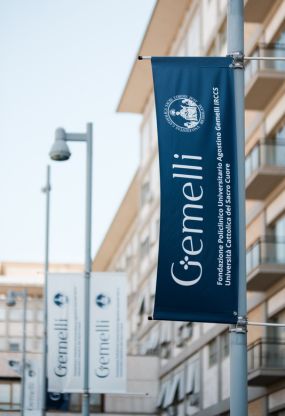Accredited School
The Postgraduate School introduces itself
Welcome to the Postgraduate School of Radiodiagnostics of the A. Gemelli Faculty of Medicine and Surgery on the Rome campus of Università Cattolica del Sacro Cuore
The specialist in Radiodiagnostics must have gained knowledge in traditional and digital radiology, diagnostic and therapeutic angiography, computed tomography, magnetic resonance imaging, ultrasound and bone densitometry and be able to perform a total number of diagnostic tests to meet the established educational objectives.
For the School of Specialisation in RADIODIAGNOSTICS (divided into four years of course) the educational objectives are as follows:
Basic learning objectives:
- radiation physics;
- physical bases of image formation in traditional radiology, computed tomography, ultrasonography, magnetic resonance imaging and nuclear medicine;
- quality controls;
- radiation protection and iatrogenic damage;
- radiobiology;
- COMPUTER SCIENCE;
- human anatomy, clinical radiological anatomy, physiology, biochemistry, molecular biology, pharmacology, pathological anatomy.
Educational objectives of the type of School:
- instrumentation and materials used in diagnostic imaging and interventional radiology;
- pharmacology and clinics of the different organs and systems in order to be able to work in close collaboration with clinical colleagues from other disciplines;
- methodology to be applied in relation to the various pathologies as well as the possibility of morphological and functional study of organs and systems both with methods that use ionizing radiation and with those that use non-ionizing radiation;
- know how to carry out angiographic examinations and interventional radiology procedures of the various organs and systems, as well as the specific indications in comparison with surgical therapies.
Integrated training objectives (i.e. common core): the student must have acquired the scientific bases and theoretical-practical preparation necessary for the exercise of the profession of specialist and the methodology and culture necessary for the practice of lifelong learning, as well as a level of professional, decision-making and operational autonomy deriving from the training course followed. The student must acquire: the essential knowledge deriving from the basic sciences, underlying all the different articulations of the training courses and indispensable for the knowledge of the equipment and for the correct application of procedures and methods; the fundamental knowledge of molecular biology and genetics, the advanced knowledge on the etiopathogenic mechanisms of neoplastic disease, the theoretical knowledge and clinical practice adequate for the prevention, diagnosis, therapy and follow-up of the neoplastic patient; finally, the clinical knowledge necessary for an accurate classification of pathologies in order to be able to optimally exercise the correct diagnostic, interventional or therapeutic options, also in compliance with current regulations in the field of radiation protection and protection, evaluating risks, costs and benefits; the ability to communicate clearly and humanely with the patient and family members. Finally, the resident must acquire the ability to interact with attending physicians and other specialists, as well as to collaborate with other professionals in the radiology area and the ability to interpret scientific English.
The following are similar or supplementary objectives:
- the organisational and administrative methods of a Diagnostic Imaging and Interventional Radiology service, managing its human, instrumental and economic resources;
- medical-legal problems inherent in the profession of radiologist;
- basic elements of scientific methodology necessary for the understanding of the scientific literature and for the development of individual research.
The following are compulsory professionalizing activities for the achievement of the educational purposes of the type:
The attendance of the Operating Units, the General and Special Services of the Diagnostic Imaging Departments having collaborated in the realization and reporting of diagnostic and interventional radiology examinations as indicated below:
- For 2 months, participation in the technical and methodological execution of at least 250 echotomography investigations, including echo-Doppler examinations.
- For 2 months, participation in the technical and methodological execution of at least 250 computed tomography investigations and examinations in hybrid machines.
- For 2 months, participation in the technical and methodological execution of at least 200 Magnetic Resonance examinations.
- For 8 months, participation in the execution and interpretation of at least 1500 conventional radiology investigations of the respiratory, skeletal, gastroenteric, urinary systems, including dental and maxillofacial activity and bone mineralometry.
- For 8 months, participation in the execution and interpretation of at least 800 investigations of the respiratory, gastrointestinal and genitourinary systems in the integrated imagery.
- For 4 months, participation in the execution and interpretation of at least 300 neuroradiology investigations.
- For 6 months, participation in the execution and interpretation of at least 400 cardiovascular and interventional radiology investigations.
- For 5 months, participation in the execution and interpretation of at least 500 emergency radiology and first aid investigations.
- For 5 months, participation in the execution and interpretation of at least 500 breast radiology investigations.
- For 2 months, participation in the execution and interpretation of at least 200 pediatric and neonatological radiology investigations.
The student will be able to compete for the diploma after completing the professionalizing activities.
As part of the training course, the student will have to learn the scientific bases of the type of School in order to achieve full maturity and professional competence that includes an adequate ability to interpret scientific innovations and critical knowledge that allows him to consciously manage both assistance and his own updating; In this context, participation in meetings, congresses and the production of scientific publications and periods of attendance in qualified Italian and foreign institutions useful for his/her training may be envisaged.




